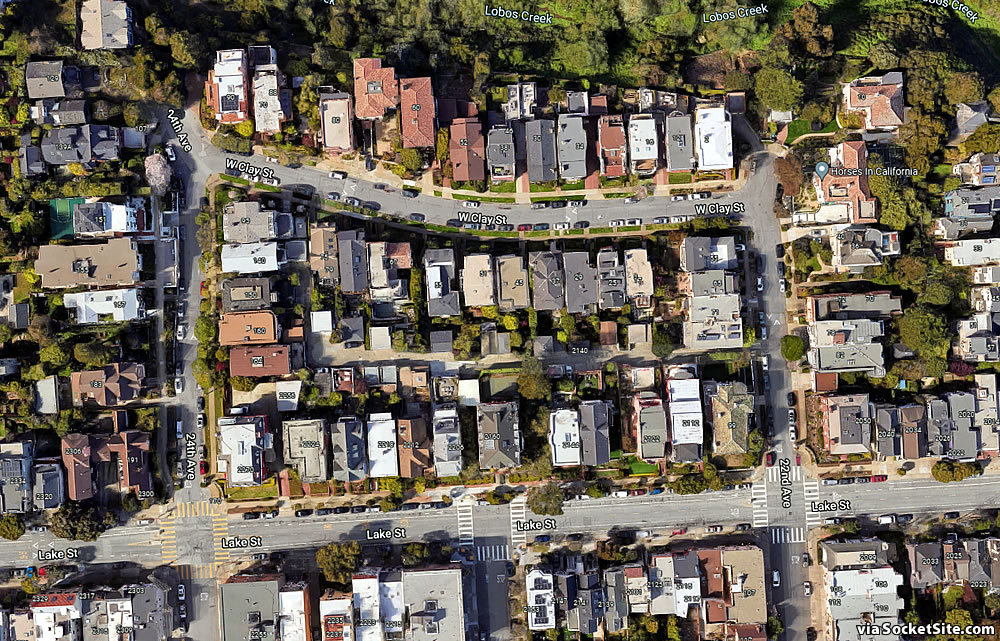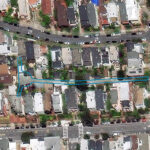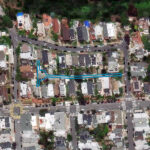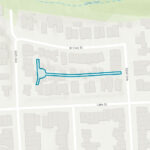Having just hit the market for one million dollars and positioned as a “unique and irregularly shaped interior lot…located in the beautiful Richmond District,” a lot that “IS buildable” and could yield “a very unique residence” (“with some creativity and imagination of a great designer,” all per the lot’s listing agent), we challenge you to find the lot that’s 34 22nd Avenue without scrolling down.
Technically, the 7,200-square-foot lot is zoned for a single-family home and development up to 40 feet in height, which might come as a surprise to the nearly 30 homes that abut the lot.
And the listing might come as an even bigger surprise to the 20-ish homes which currently use the “lot” as a private drive to access their garages.
No, we’re not kidding but we are shaking our heads and will keep you posted and plugged-in.




Constraints often lead to architectural innovation.
Can’t wait to see renderings!
/s
I assume this is a cynical “plot” to get all the homeowners with a garage on that driveway to pay the $1M in defense of their garages.
I had the same thought.
But given that the owner apparently can’t afford the ~$1200/year in property taxes, if I owned one of those garages, I’d rally my neighbors to hire an attorney and sue the owner of the driveway lot. Doesn’t really matter what you sue him for, just tie the thing up for a couple of years until the city takes it and auctions it off. Then buy the lot for a tiny fraction of the million dollar price and put an easement on it so this can’t happen again.
Putting aside the ridiculousness of this lot for a moment, your comment is the embodiment of a large portion of this city’s issue.
Protectionism, using the overcomplicated web of California’s laws and regulations as not a shield, but a weapon.
I won’t presume to know you personally, but behavior like what your describe is why this city is on the verge of losing all local housing control.
With that in mind then, I guess, carry on.
Why blame the culture of the City? Seems to me it’s the modus operandi of a least one former president…
Given the undoubted decades that the the garages have been there – about as “open and blatant use” as one could imagine – there could be a strong adverse possession / prescriptive easement case here. So it’s not so much cynical as ill-advised and childish.
(Or if there are already written driveway easements, then this lot is in fact *not* buildable, unless all those easements are voluntarily terminated by the adjacent owners – a feat which I expect would cost many times more than $1 million to accomplish.)
Wow. It’s hard to believe that the driveway could/would have been built without an easement.
Sounds like those 20-ish homes need to get together and buy the lot if they want to preserve their access to garages.
Also worth pointing out that property taxes on the parcel have not been paid since 2019, and the owner is in default on the three subsequent years. My recollection is that the city will foreclose and auction the property off once it gets five years in arrears.
The property last sold in 2015 for $10,100, so a million dollar sale would be quite a return on investment.
Property taxes on $10,100 can’t be that much and they couldn’t pay that?
No point in paying taxes if the lot can’t be developed or is encumbered. Reads like saber rattling in hope of a settlement with the neighbors or enticing a greater fool.
No point in buying the property in 2015 if the lot can’t be developed or is encumbered.
Sure there is. $10k is peanuts when compared to the opportunity to flip the lot to someone, possibly remote or even from some other country who wants to invest their wealth off shore, for many times that amount.
The current owner is probably counting on paying the back taxes when the money comes in from some buyer who read on the internet somewhere that the S.F. real estate market is filled with people willing to overpay for housing and that property here is a can’t lose investment. As long as the ultimate buyer finds out that as a practical matter the lot can’t be developed after the closing, the owner and his agent will be laughing about this all the way up the back nine.
An impressive display of missing my point entirely.
Maybe it was not clear enough: responding to Michael’s comment, if there is no point in paying taxes today, then there was no point in buying the place in 2015.
Disagree. Good chance the neighbors will settle for more than $10K or Brahma is correct.
And if there was a chance of it happening before the purchase in 2015, then it was the same today.
That’s incorrect. The parcel appears to have been opportunistically acquired by way of a tax default sale. And while the acquiring party might have been ignorant to the conditions at hand, the acquiring party obviously has different motivations and leverage than the group that appears to have let ownership of the parcel slip out of their hands.
Because interest rates are rising, the seller is a lot more motivated to sell now than they were in 2015. They will probably sell for less money than they would in 2015, either to a low-information buyer or to the surrounding homeowners.
If it has been used for more than 5 years as a driveway for 20+ homes, wouldn’t all of those homeowners using it for garage access have a prescriptive easement? Or is there a formal easement on the property?
Sounds like the adjacent homes most likely have prescriptive easement rights if they have been openly using the land as driveway to access their properties for over 5 years. It might be difficult if not impossible to develop the ground level.
But there is 40 Ft building height limit (4 floors). Would it be possible to build a home on a podium structure on floors 2-4, at the wider end of the lot? While a podium structure over the more narrow parts could possibly support elevated deck garden space, or solar panels?
“Would it be possible to build a home on a podium structure on floors 2-4, at the wider end of the lot?”
Jeff Shelton has shown it can be done.
OMG, I love that! Thank you for the link.
Yes, Shelton’s work is amazing. If you’re in downtown Santa Barbara then I recommend a self guided tour of his buildings. Most are visible from the street and all are delightful.
Jeff Shelton is what would have happened if Jim Woodring became an architect.
Some opportunist thought they were quite clever by snatching this up, ala the Presidio Terrace debacle (which failed for different reasons). The only real opportunity here is to pay property tax on some rich folks’ driveways for them.
So realistically, nothing will ever get built on this plot. What happens to the land when it goes back into default? The smart thing to do would be for those homes to buy it at auction for the $10-15k it’s actually worth and start an HOA. But what if they don’t? Do we just repeat this tale over and over or is it possible the city could just christen this an actual street?
It’s clear from the assessor’s block map that this was intended as alley access to the garages as built – in the 1935 map it doesn’t even show up as a lot. And by 1946 it’s listed as “State Property”. How did it end up in private hands?
This happened in 2018 when a couple bought the street of Presidio Terrace because the local HOA failed to pay the property taxes. The SF board of supervisors stepped in and overturned the 90k purchase. Friends in high places and all. Google “Presidio Terrace Michael Cheng”
Seacliff has a number of these rear-access alleys. They should have been dedicated to the city when the maps were recorded or preferably, made part of the adjacent lots with an easement over them to ensure owners were still obliged to maintain them privately and pay property taxes on them.
I agree there has to be more to this story: while it might make a fun read – apparently even SS isn’t immune to these “only in crazy San Fancisco” stories – it makes no sense that dozens of garages were built with no access other than over private property…for which access can be withdrawn without notice. OTOH, if access can’t be wthdrawn – i.e. easement – then the “property” would seem to be even less useful.
Either way there must be an interesting story…too bad it’s likely to stay hidden.
Yeah, have fun getting title insurance. This reminds me of the vacant triangular property at 22nd and Treat that is so encumbered by easements and unknowable claims from the surrounding properties that nobody would ever want to take the risk of trying to develop it.
Seems like an opportune Builders Remedy site!
have to agree with the listing agent about one thing…it would be a very unique residence.
There will be no naive buyer. Any agent who fails to disclose these facts is going to be in big trouble. The Chronicle or national media will probably pick it up soon, and it will become another hobby-horse for crazy SF. Also, West Clay and and this part of Lake Street have always been home to people with a presence in town, so I think we should just wait and watch the circus.
I might be wrong but unless the owner of the lot does the FiDi Class A tower alley block and have paid guards to enforce non-use for a documented 24hrs (normally on New Year’s Day or some other unnoticed day) there would factually be an easement created by “historically allowed trespass” or whatever the fancy RE phrase it that I can’t remember.
It could be a whole long legal mess but I think someone around there is connected enough to get the City to force some eminent domain purchase for less than the broke land owner would prefer.
Ultimately, the rich will not pay.
I would say that there is a good case for a prescriptive easement. There is no case for adverse possession as that would require the property taxes timely paid. There are however defenses against a prescriptive easement as the use must be hostile. If the prior owner gave permission than the prescriptive easement would fail.
However if the property is shown on the title report and or subdivision map as a road then all the property owners in the subdivision have use of the road under California law. The owner of the property should put a gate on the road give the owners a key and charge them for maintenance insurance and upkeep etc.